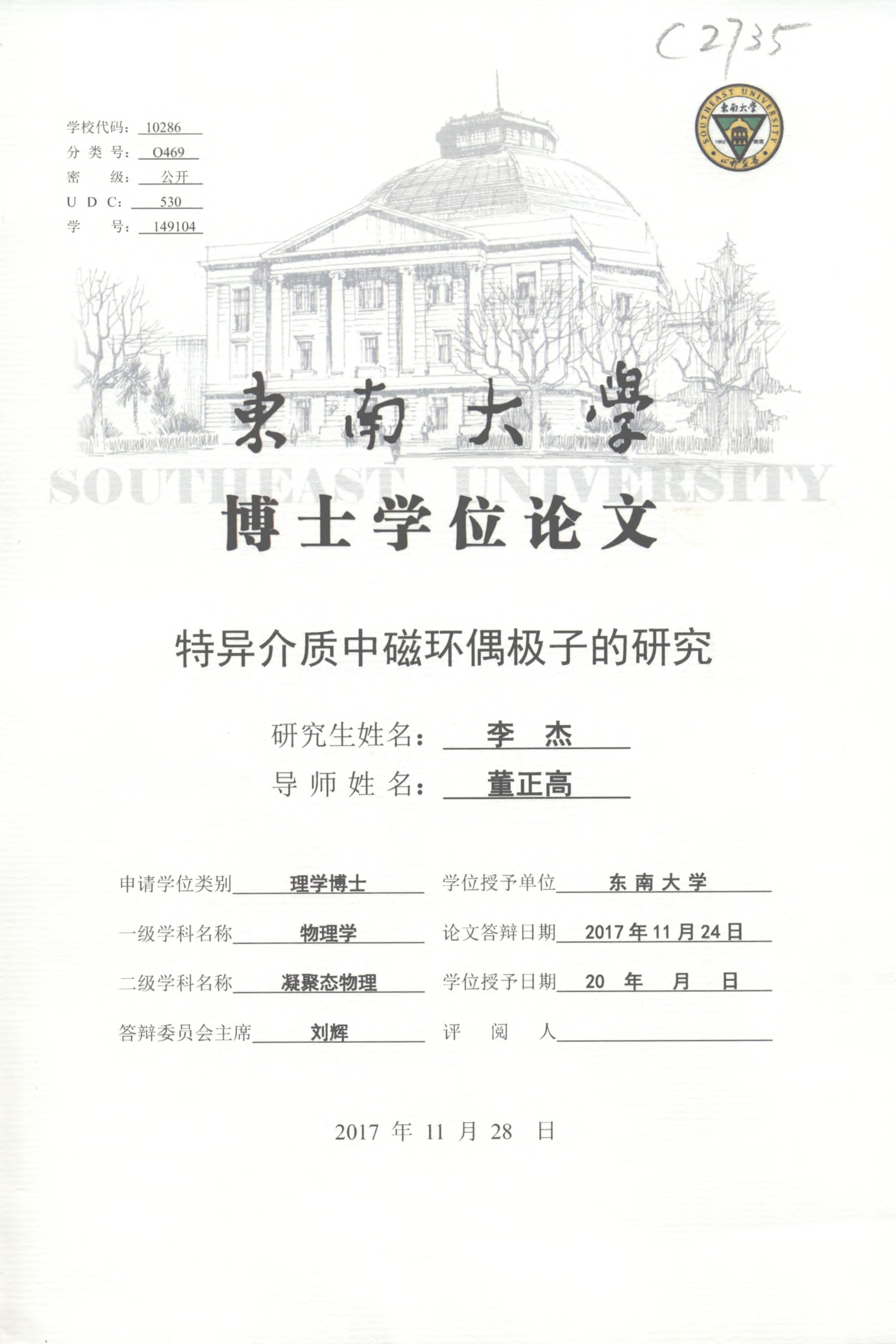
经典的电磁多极展开式可以分解为电多极和磁多极两大类,主要包括偶极、四极和八极等等。然而,事实证明,该理论并不完整。于是,在1957年,为了解释原子和核物理中弱相互作用的宇称破缺问题,Zel’dovich教授首次提出了一个新的物理概念:磁环偶极矩(toroidal dipole moment),这一概念的提出,不仅解决了之前许多电磁学领域难以解释的问题,也使得电磁理论更加完善。磁环偶极矩是电流在一个甜甜圈式的圆环面上沿中线流动而产生的,磁场呈现首尾相接的涡旋分布,极大地增强了近场局域。但是,相较于经典的电磁多极,磁环偶极矩与自由空间的耦合很微弱,致使人们很难观测到它。因此,随着环形特异介质的出现,将磁环偶极矩与特异介质结合起来,抑制经典电磁多极共振的同时极大地增强了磁环偶极共振。近几年,环形特异介质这一有趣的课题吸引了越来越广泛的关注。在本论文中,基于前人研究的基础上,我们进一步深入探讨了磁环偶极矩的光学特性以及其引起的一些新的光学效应,整个思路框架如下: 第一章,阐述了研究背景。首先,环形矩的提出、产生机制与光学特性;然后,环形特异介质的提出以及近些年来的发展过程。 第二章,简单阐述了相关的理论基础以及计算方法。首先,色散理论:Drude模型和Lorentz模型;其次,电磁场数值分析方法:有限元法和时域有限差分法;电磁仿真软件:CST Microwave Studio和HFSS。 第三章,探讨了有孔金属圆盘特异结构中几何参数以及电磁波入射角度对磁环偶极共振的影响,并利用LC电路模型进行分析。 第四章,通过磁环偶极共振来操控偶极激发源的远场辐射并探讨了其耦合机制,促进了光与物质相互作用等方面的发展。 第五章,将增益材料嵌入到有孔金属圆盘特异结构中,研究增益材料对偶极激发源超辐射强度的影响,在操控光与物质相互作用方面将有所应用。 第六章,通过磁环偶极共振与电偶极共振相互耦合,产生了类电磁诱导透明现象;通过调节几何参数,两者的不对称耦合则会产生双带的类电磁诱导透明现象。在传感应用方面,提供了新的实现途径。 第七章,为了避免金属的欧姆损耗,提出了具有高介电常数的钽酸锂介质微管,研究几何参数对磁环偶极共振频率、场热点(Hotspot)以及品质因数的影响,并探讨了其产生的物理机制。 第八章,提出深度不对称金属圆槽特异结构,实现了电磁波正入射下的磁环偶极共振,讨论了其产生物理机制;着重讨论了由磁环偶极共振引起的场热点和完美吸收光学效应。第九章,全文总结及展望。 关键字:磁环偶极共振,环形特异介质,远场辐射,超辐射,场热点,完美吸收
The classic electromagnetic expansion of of multipoles can be decomposed into electric and magnetic multipoles, primarily including dipoles, quadrupoles, octupoles, and so on. But, it was proved that this electromagnetic theory is not complete. So, in 1957, Zel’dovich firstly proposed the toroidal dipole to explain the parity violation in the weak interaction, not only solving the puzzles in physics but also completing the electromagnetic multipolar theory. Toroidal dipole arises from a current flowing on the surface of a torus along its meridian and presents a head-to-tail distribution of magnetic field, greatly strengthening the near-field localization. However, compared with other conventional multipolar responses, toroidal dipole response couples weakly to free space and is hardly to be detected. Therefore, toroidal metamaterials connect toroidal dipole response and novel optical behaviors, in terms of suppressing other classic multipole responses while strengthening the toroidal dipole resonance. In recent years, the interesting topic of toroidal metamaterials have attracted a growing attention. In this dissertation, based on the previous research, we further explore the optical properties of toroidal dipole response and optical effects. The overall frame of the dissertation is following: In the first chapter, the research background is introduced. First, the proposal, excitation mechanism and optical properties of toroidal dipole resonance; Then, the proposal and evolution of toroidal metamaterial. In the second chapter, the relevant theoretical basis and computing method is presented. First, the dispersion models: Drude model and Lorentz model; Then, electromagnetic numerical analysis methods: Finite element method and finite difference time domain method; Finally, the simulated softwares: CST Microwave Studio and HFSS. In the third chapter, we explore the influence of geometric parameters of double-disk metamaterial as well as the incident angle of electromagnetic wave, which is explained by the LC-circuit model. In the fourth chapter, the farfield-radiating of dipolar emitter can be manipulated by the toroidal dipole resonance, and the coupling physical mechanism is also explored. The study provides potential applications in light-matter interaction. In the fifth chapter, the gain material is embedded into the variation structure of double-disk metamaterial and the effect of gain material on the super-radiating of dipolar emitter is also studied, promoting the development of light-matter interaction. In the sixth chapter, an analog of electromagnetically induced transparency (EIT) occurs by the coupling between toroidal and electric dipoles. Besides, by tuning the geometric parameter, the dual-band EIT appears due to an asymmetric coupling between toroidal and electric dipoles. The study provides a new way for the sensor. In the seventh chapter, to overcome the metal loss in toroidal metamaterials, a LiTaO₃ microtube with high dielectric constant is proposed and, then, the effect of geometric parameters on the toroidal dipole resonance, intensity of field hot spot and Q-factor is studied. Besides, the physical mechanism is also explored. In the eighth chapter, a depth-asymmetry circular groove metamaterial is designed to obtain the toroidal dipole resonance under normal incidence and the physical mechanism is explored. Above all, the optical effects including the field hot-spot and perfect absorption induced by toroidal dipole resonance is deeply explored. In the ninth chapter, the conclusion and perspective. Keywords: toroidal dipolar moment, toroidal metamaterial, farfield-radiating, super-radiating, field hot-spot, perfect absorption